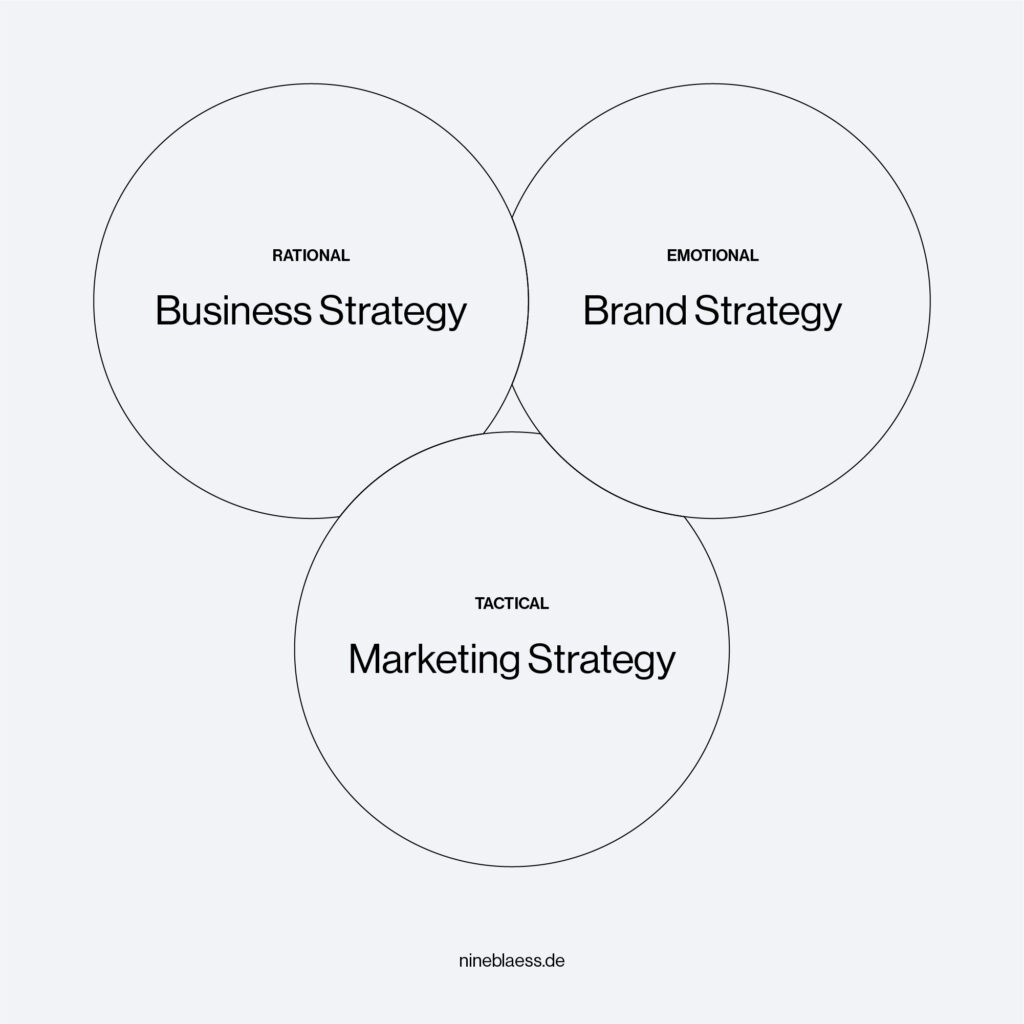Are you struggling to give your business a clear direction or stand out from the crowd? If so, a solid strategy may be the missing ingredient. But with so many different strategies out there, it can be challenging to know which one is right for your situation. Business strategy, brand strategy or marketing strategy—what’s even the difference?
Let’s explore the differences between those strategies and how each can help take your business to the next level.
Typically, businesses tend to develop their business strategy before moving on to brand strategy and then marketing strategies. But, since these strategies are not static and require regular reevaluation, this approach is only partially true. In fact, there is some overlap between all of them.
What is Business Strategy?
A business strategy is a high-level rational plan that outlines how a company will achieve its long-term goals. Business strategy is concerned with the overall direction of a company and how it will create value for its stakeholders.
Business strategy focuses on topics such as:
- Growth opportunities: Identifying and implementing opportunities for the company to grow, such as expanding into new markets, introducing new products or services, or forming strategic partnerships.
- Resource allocation: Allocate financial, human, and technological resources to maximise return on investment (ROI) and achieve other business objectives.
- Operational efficiency: Improve operational efficiency by streamlining processes, adopting new technologies and reducing costs.
- Risk management: Identifying and managing potential risks, such as changes in the market, regulatory changes, or natural disasters, that could affect the company.
- Financial Management: Ensuring the long-term financial sustainability of the business through effective budgeting and financial planning.
What is Brand Strategy?
When business strategy is the rational part, brand strategy is its emotional counterpart. A Brand strategy is a plan that outlines how a company will build and manage its brand to appeal to people on an emotional level. The brand strategy focuses on creating a standout brand identity that reflects the company, resonates with the consumer and differentiates the organisation from its competitors.
The brand strategy includes elements like:
- Brand Positioning: Defining the unique position of a brand in the marketplace. How does it differentiate itself from competitors?
- Brand mission, vision and values: Identifying why a brand exists beyond making a profit. What are the vision and mission? What brand values does it stand for?
- Brand Personality: Defining a unique brand personality and tone of voice to make the brand more relatable to its target audience.
- Brand Messaging & storytelling: Creating consistent messaging and brand stories that effectively communicate the brand’s values and resonate with its audience.
- Visual Identity: Develop a visual identity that is consistent with the target audience, positioning and personality of the brand. All visual brand elements such as the logo, brand colours, brand typography and other design elements are documented in brand guidelines.
What is Marketing Strategy?
A marketing strategy is a tactical plan that outlines how a company will promote its products or services. Marketing strategy focuses on driving sales and revenue growth through effective promotion.
It focusses on things like:
- Market Segmentation: Dividing the target audience into smaller groups based on demographics, psychographics, or other factors and developing targeted marketing for each segment.
- Marketing Mix: Identifying the right combination of product, price, promotion, and distribution channels to reach the audience and drive sales.
- Content Marketing: Creating high-quality content that educates, entertains, or inspires the target audience and drives engagement and conversion.
- Lead Generation & Sales Funnels: Develop strategies to generate leads and capture customer information, such as email campaigns, lead magnets, or landing pages. Then, create a step-by-step process for converting these leads into paying customers.
- Analytics and Metrics: Establish metrics and track the effectiveness of the marketing strategy, such as website traffic, conversion rates, customer acquisition cost, and customer lifetime value.

Summary
In a nutshell, business strategy focuses on the overall direction of the company (rational), brand strategy on building a distinct brand identity (emotional), and marketing strategy on promoting products or services to consumers (tactical).
In reality, these strategies may overlap. In fact, my brand strategy process addresses some business and marketing strategy topics, too.
As you see, a solid strategy is essential for any business looking to achieve long-term success. By understanding the differences between business, brand, and marketing strategies, you can develop a strategic approach that fits your company’s unique needs.
If you found these definitions interesting, you might like my brand glossary, too.
If you’re looking for help with your brand strategy, let’s have a chat.
Title image by Kaboompics






